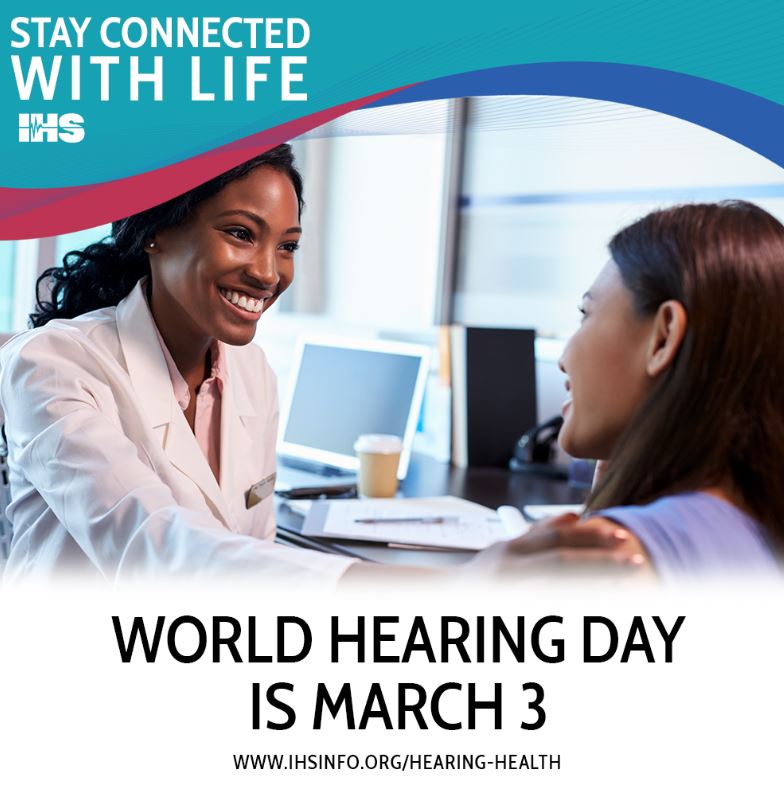LIVONIA, MICHIGAN — The International Hearing Society (IHS) in conjunction with World Health Organization (WHO) recognize March 3 as World Hearing Day to raise awareness of hearing healthcare. According to WHO, about 1.5 billion people globally have hearing loss, and in the United States alone, approximately 37.5 million individuals experience some degree of hearing loss. To address this issue, IHS is launching a consumer awareness campaign titled “Stay Connected With Life” to connect people to licensed hearing healthcare professionals who can provide hearing solutions.
 “International Hearing Society is pleased to partner with WHO in recognizing March 3 as World Hearing Day to help more people prevent and address hearing issues. IHS plans to expand the reach of this important initiative with the launch of our “Stay Connected With Life” consumer awareness campaign. I encourage all individuals to have their hearing checked and discover their hearing baseline from a licensed hearing healthcare provider, some of whom can be identified through our free directory: www.ihsinfo.org. Hearing protection and communication solutions are available to so many who will take the first step in visiting a hearing healthcare provider,” said IHS Executive Director Alissa Parady.
“International Hearing Society is pleased to partner with WHO in recognizing March 3 as World Hearing Day to help more people prevent and address hearing issues. IHS plans to expand the reach of this important initiative with the launch of our “Stay Connected With Life” consumer awareness campaign. I encourage all individuals to have their hearing checked and discover their hearing baseline from a licensed hearing healthcare provider, some of whom can be identified through our free directory: www.ihsinfo.org. Hearing protection and communication solutions are available to so many who will take the first step in visiting a hearing healthcare provider,” said IHS Executive Director Alissa Parady.
“As a hearing healthcare provider and Canadian, I am so proud to stand with WHO on World Hearing Day and encourage people around the world to “Stay Connected With Life,” the theme of IHS’ Consumer Awareness Campaign. IHS is a global Society, representing hearing healthcare professionals from 18 countries. Our members include Hearing Aid Specialists and Audiologists who serve the needs of their local communities across the globe, making care accessible and communication solutions achievable. “I want to remind individuals to have their hearing tested on an annual basis, just as they would their eyes, teeth, and other physical checkups. Communication with one’s loved ones, employers, and caretakers, enables people to Stay Connected With Life, and hearing aid specialists provide individuals that ability on a daily basis. Find a hearing aid specialist near you to determine whether you have hearing loss or hearing aids may be helpful by visiting www.ihsinfo.org.”
–Annette Cross, BC-HIS, Immediate Past President of IHS
GLOBAL STATISTICS: Left unaddressed, WHO predicts that the number of people who experience hearing loss could rise to more than 2.5 billion by 2050—that is one in four people. More than 1 billion young people (12-35 years old) are at risk for hearing loss due to recreational exposure to loud sound. WHO estimates that unaddressed hearing loss costs the global economy US$ 980 billion annually due to health sector costs (excluding the cost of hearing devices), costs of educational support, loss of productivity, and societal costs.
U.S. STATISTICS: Check out these statistics from the U. S. National Institutes of Health* and move into action to protect and take steps to enhance and protect your hearing today! (https://www.nidcd.nih.gov/health/statistics/quick-statistics-hearing)
- Approximately 15% of American adults (37.5 million) aged 18 and over report some trouble hearing.
- Among adults aged 20-69, the overall annual prevalence of hearing loss dropped slightly from 16 percent (28.0 million) in the 1999-2004 period to 14 percent (27.7 million) in the 2011–2012 period.
- Age is the strongest predictor of hearing loss among adults aged 20-69, with the greatest amount of hearing loss in the 60 to 69 age group.
- Men are almost twice as likely as women to have hearing loss among adults aged 20-69.
- Non-Hispanic white adults are more likely than adults in other racial/ethnic groups to have hearing loss; non-Hispanic black adults have the lowest prevalence of hearing loss among adults aged 20-69.
- About 18 percent of adults aged 20-69 have speech-frequency hearing loss in both ears from among those who report 5 or more years of exposure to very loud noise at work, as compared to 5.5 percent of adults with speech-frequency hearing loss in both ears who report no occupational noise exposure.
- One in eight people in the United States (13 percent, or 30 million) aged 12 years or older has hearing loss in both ears, based on standard hearing examinations.
- About 2 percent of adults aged 45 to 54 have disabling hearing loss. The rate increases to 8.5 percent for adults aged 55 to 64. Nearly 25 percent of those aged 65 to 74 and 50 percent of those who are 75 and older have disabling hearing loss.
- Roughly 10 percent of the U.S. adult population, or about 25 million Americans, has experienced tinnitus lasting at least five minutes in the past year.
- About 28.8 million U.S. adults could benefit from using hearing aids.
- Among adults aged 70 and older with hearing loss who could benefit from hearing aids, fewer than one in three (30 percent) has ever used them. Even fewer adults aged 20 to 69 (approximately 16 percent) who could benefit from wearing hearing aids have ever used them.
For more information on the IHS campaign, visit: https://www.ihsinfo.org/consumers/hearing-health
#stayconnectedwithlife
#worldhearingday
#hearingcare
**Interested readers can also view a recent interview with Dr. Shelly Chadha to learn more about World Hearing Day and the WHO’s work to address hearing health on a global scale:
About the International Hearing Society
The International Hearing Society (IHS) is a membership association that represents hearing healthcare professionals worldwide, including hearing aid specialists. IHS members are engaged in the practice of performing hearing assessments, selecting, fitting, and dispensing hearing instruments, counseling patients, and providing aftercare services. Founded in 1951, IHS protects, represents, and promotes the interests of hearing healthcare and hearing healthcare professionals.
Source: IHS






